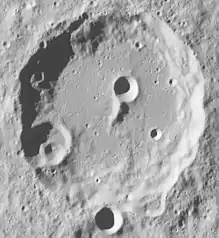 LRO global mosaic image | |
| Coordinates | 50°37′S 30°34′E / 50.61°S 30.57°E |
|---|---|
| Diameter | 79.85 km |
| Depth | 3.0 km |
| Colongitude | 330° at sunrise |
| Eponym | Bartholomaeus Pitiscus |

Pitiscus is a lunar impact crater that lies in the southern part of the Moon's near side, just to the northwest of the larger crater Hommel. It was named after German mathematician Bartholomaeus Pitiscus in 1935.[1] The crater is worn, but still forms a prominent feature upon the surface. The rim is roughly circular, but appears oval from the Earth due to foreshortening. There is an outward bulge to the south-southeast where the interior has slumped. The remainder of the inner wall still displays terraces, although they are worn and rounded due to erosion.
The interior floor is level and appears to have been resurfaced by lava. There is a low central peak formation at the midpoint of the interior, and the northern end of this ridge is overlaid by the circular crater Pitiscus A. A slumped and somewhat irregular crater, Pitiscus E, lies along the inner wall to the west-southwest. The interior floor is also marked by several other tiny craters alongside the eastern interior wall.
Satellite craters
By convention these features are identified on lunar maps by placing the letter on the side of the crater midpoint that is closest to Pitiscus.
| Pitiscus | Latitude | Longitude | Diameter |
|---|---|---|---|
| A | 50.3° S | 30.9° E | 10 km |
| B | 47.7° S | 30.5° E | 25 km |
| C | 47.1° S | 28.3° E | 17 km |
| D | 49.0° S | 26.5° E | 22 km |
| E | 50.9° S | 29.3° E | 13 km |
| F | 46.9° S | 29.5° E | 13 km |
| G | 47.6° S | 25.2° E | 15 km |
| J | 48.2° S | 26.5° E | 7 km |
| K | 46.3° S | 29.9° E | 16 km |
| L | 51.2° S | 33.6° E | 9 km |
| R | 48.6° S | 28.3° E | 25 km |
| S | 47.7° S | 27.6° E | 28 km |
| T | 46.9° S | 27.9° E | 8 km |
| U | 48.9° S | 33.3° E | 6 km |
| V | 49.3° S | 34.3° E | 5 km |
| W | 50.3° S | 27.7° E | 24 km |
References
- ↑ "Pitiscus (crater)". Gazetteer of Planetary Nomenclature. USGS Astrogeology Research Program.
- ↑ The geologic history of the Moon. USGS Professional Paper 1348. By Don E. Wilhelms, John F. McCauley, and Newell J. Trask. U.S. Government Printing Office, Washington: 1987. Table 9-4.
- Andersson, L. E.; Whitaker, E. A. (1982). NASA Catalogue of Lunar Nomenclature. NASA RP-1097.
- Bussey, B.; Spudis, P. (2004). The Clementine Atlas of the Moon. New York: Cambridge University Press. ISBN 978-0-521-81528-4.
- Cocks, Elijah E.; Cocks, Josiah C. (1995). Who's Who on the Moon: A Biographical Dictionary of Lunar Nomenclature. Tudor Publishers. ISBN 978-0-936389-27-1.
- McDowell, Jonathan (July 15, 2007). "Lunar Nomenclature". Jonathan's Space Report. Retrieved 2007-10-24.
- Menzel, D. H.; Minnaert, M.; Levin, B.; Dollfus, A.; Bell, B. (1971). "Report on Lunar Nomenclature by the Working Group of Commission 17 of the IAU". Space Science Reviews. 12 (2): 136–186. Bibcode:1971SSRv...12..136M. doi:10.1007/BF00171763. S2CID 122125855.
- Moore, Patrick (2001). On the Moon. Sterling Publishing Co. ISBN 978-0-304-35469-6.
- Price, Fred W. (1988). The Moon Observer's Handbook. Cambridge University Press. ISBN 978-0-521-33500-3.
- Rükl, Antonín (1990). Atlas of the Moon. Kalmbach Books. ISBN 978-0-913135-17-4.
- Webb, Rev. T. W. (1962). Celestial Objects for Common Telescopes (6th revised ed.). Dover. ISBN 978-0-486-20917-3.
- Whitaker, Ewen A. (1999). Mapping and Naming the Moon. Cambridge University Press. ISBN 978-0-521-62248-6.
- Wlasuk, Peter T. (2000). Observing the Moon. Springer. ISBN 978-1-85233-193-1.
External links
 Media related to Pitiscus (crater) at Wikimedia Commons
Media related to Pitiscus (crater) at Wikimedia Commons